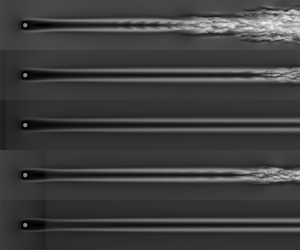Article contents
Direct numerical simulation of roughness-induced transition controlled by two-dimensional wall blowing
Published online by Cambridge University Press: 11 June 2021
Abstract

Discrete roughness-induced transition in Mach  $2.25$ flow controlled by two-dimensional wall blowing is studied using direct numerical simulation. Spectral analysis and flow freezing operations reveal that the main source of unsteadiness in the case without blowing is the separated shear layer/counter-rotating vortex system: the shear layer is bent by the vortex pair, and this interaction induces disturbance growth at the shear layer. With the existence of weak wall blowing, the transition is delayed. Flow visualization demonstrates that upstream-positioned blowing achieves this by lifting the inflow boundary layer and decreasing the roughness Reynolds number. In contrast, downstream-positioned blowing takes effect by weakening the counter-rotating vortex pair and inhibiting the interaction. Vorticity transportation analysis suggests that this result is accomplished by increasing dissipation for streamwise vorticity and converting some of it into spanwise vorticity. In cases with strong wall blowing, the control effect is reversed, as wall blowing with enough strength can induce unsteadiness and promote transition. In upstream-positioned strong blowing cases, a new unstable mode is observed in spectral results throughout the near-roughness region, and further analysis indicates that this mode originating from the separation zone upstream of the blowing is the key factor for transition. With regard to downstream-positioned strong blowing cases, a very low-frequency mode is generated from the separation bubble between the roughness element and the blowing, but it only provides an initial disturbance for the transition process. The transition that occurs downstream is due to the distortion of the boundary layer in the wake.
$2.25$ flow controlled by two-dimensional wall blowing is studied using direct numerical simulation. Spectral analysis and flow freezing operations reveal that the main source of unsteadiness in the case without blowing is the separated shear layer/counter-rotating vortex system: the shear layer is bent by the vortex pair, and this interaction induces disturbance growth at the shear layer. With the existence of weak wall blowing, the transition is delayed. Flow visualization demonstrates that upstream-positioned blowing achieves this by lifting the inflow boundary layer and decreasing the roughness Reynolds number. In contrast, downstream-positioned blowing takes effect by weakening the counter-rotating vortex pair and inhibiting the interaction. Vorticity transportation analysis suggests that this result is accomplished by increasing dissipation for streamwise vorticity and converting some of it into spanwise vorticity. In cases with strong wall blowing, the control effect is reversed, as wall blowing with enough strength can induce unsteadiness and promote transition. In upstream-positioned strong blowing cases, a new unstable mode is observed in spectral results throughout the near-roughness region, and further analysis indicates that this mode originating from the separation zone upstream of the blowing is the key factor for transition. With regard to downstream-positioned strong blowing cases, a very low-frequency mode is generated from the separation bubble between the roughness element and the blowing, but it only provides an initial disturbance for the transition process. The transition that occurs downstream is due to the distortion of the boundary layer in the wake.
- Type
- JFM Papers
- Information
- Copyright
- © The Author(s), 2021. Published by Cambridge University Press
References
REFERENCES
- 9
- Cited by





